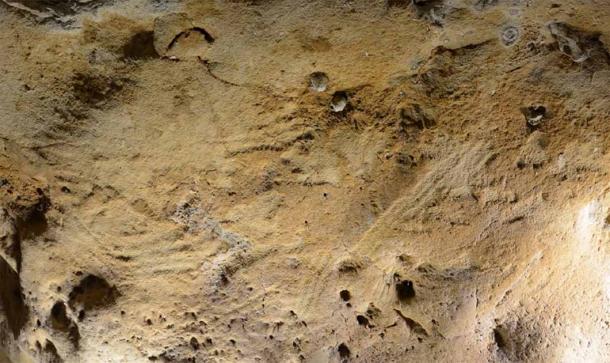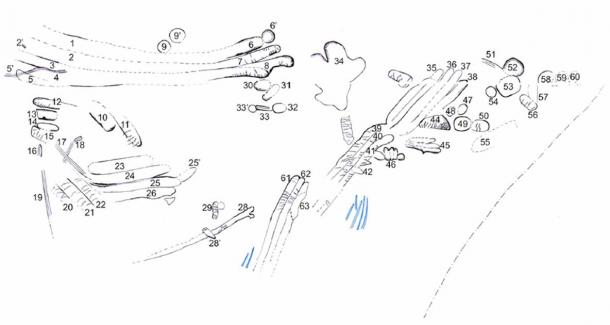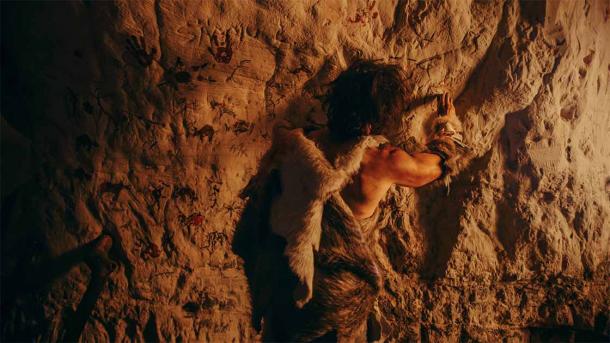
Study Finds Oldest Ever Neanderthal Cave Engravings, Destroying Established Timeline
In recent years, interest in the subject of Neanderthal cave art has exploded, as new discoveries have illuminated the fascinating truth about the artistic abilities and advanced symbolic understanding of our now-extinct human cousins. A new study published in the journal PLOS ONE has revealed that archaeologists in France have found what they believe to be the oldest Neanderthal cave engravings ever discovered, pushing back the date for Neanderthal artistic dexterity to an astonishing 75,000 years in the past.

Examples of Neanderthal cave engravings discovered in the Roche-Cotard cave (Indre et Loire - France). On the left, the "circular panel" (ogive-shaped tracings) and on the right the "wavy panel" (two contiguous tracings forming sinuous lines). (Jean-Claude Marquet / PLoS ONE)
The Journey from “Wall Markings” to “Neanderthal Cave Engravings”
While exploring La Roche-Cotard Cave in the Centre-Valde Loire region of north central France, archaeologists long ago discovered a series of non-figurative wall markings known as finger flutings. These are simply marks or impressions made by people who scraped their fingers across the soft surfaces of cave walls, leaving behind visible designs that were well protected from the forces of erosion and therefore could remain preserved indefinitely.
- Gorham’s Cave: Did Neanderthals Create Art? (Video)
- The Oldest Art in the World Wasn’t Made By Homo Sapiens
It is known that finger flutings were frequently made by humans who lived in Europe during the Upper Paleolithic period (40,000 to 10,000 years before the present). It was therefore reasonable to assume that the markings in La Roche-Cotard were left by prehistoric modern humans who occupied the cave during that time frame. Interestingly, some experts weren’t even certain the markings were finger flutings, believing the markings might have been created by nature instead.
To settle the question once and for all, a team of researchers from France, Denmark, Portugal, Hungary and Switzerland, led by archaeologist Jean-Claude Marquet from the University of Tours, applied the latest in computer-aided 3D modeling technology to study the alleged finger fluting marks in La Roche-Cotard Cave more closely.
Once they’d created precise models of the markings within the cave engravings based on photographs, the researchers compared them to finger drawings on soft rock known to have been made by human hands. This included finger flutings found in caves and replicas intentionally made in laboratories.
Looking at the 3D models and comparing them to human-made cave engravings, the researchers noted great similarities in shape, spacing, arrangement and wall location. Based on the obvious overlaps, they concluded that the markings from La Roche-Cotard were authentic finger flutings and that they had been put there intentionally by someone a very long time ago. But who exactly made the markings, and just as importantly, when did they make them?


Sample of the Neanderthal cave engravings under analysis (above) and drawing showing the limits of the finger flutings in black (below). (J. Esquerre & H. Lombard / PLoS ONE)
Deciphering Neanderthal Cave Engravings in Prehistoric Finger Art
To answer these questions, the scientists made an effort to determine the antiquity of the site using a dating technique known as optically-stimulated luminescence. They ultimately discovered that the cave had been sealed off by infill approximately 57,000 years ago, and they knew that the cave art had already been there at that time.
Notably, this was 10,000-15,000 years before modern humans arrived in Europe, leaving Neanderthals as the only possible suspect. Over the years, archaeologists have found many Mousterian tools in the cave, and since this tool industry is most closely associated with Neanderthals there seems no reason to doubt that these hominin human relatives were responsible for the prehistoric finger markings.
But the most significant part of this study was revealed through an analysis of the cave’s sediment layers in the vicinity of the Neanderthal finger flutings. Recent excavations have produced some surprising results, pushing Neanderthal occupation of the cave solidly back into the Middle Paleolithic (50,000 years ago and earlier).
“Fifteen years after the resumption of excavations at the La Roche-Cotard site, the engravings have been dated to over 57,000 years ago and, thanks to stratigraphy, probably to around 75,000 years ago, making this the oldest decorated cave in France, if not Europe!” the study authors wrote, unable to contain their excitement about the remarkable Neanderthal cave engravings.
If indeed their interpretation of the evidence is correct, it means these finger flutings may have been created as many as 10,000 years before the cave art in Spain that had been previously recognized as the oldest Neanderthal artwork in Europe.

Researchers have concluded that the marks found in France are actually Neanderthal cave engravings. (Gorodenkoff / Adobe Stock)
Neanderthal Artists Active in France, Spain and Who Knows Where
Until just a few years ago, the assertion that Neanderthals were creating cave art in Europe before humans arrived remained controversial. But strong evidence in favor of the idea emerged in 2018, when a study published in the journal Science identified cave paintings and shell bead objects found at three caves in Spain as extremely ancient Neanderthal creations.
Using a precise methodology known as uranium-thorium dating to analyze carbonate deposits in these locations—Cueva de La Pasiega in Cantabria, Cueva de Maltravieso in Extremadura and Cueva de Ardales in Andalucia—the researchers involved in that study concluded that this artwork was at least 64,800 years old. These paintings and objects were then declared the oldest cave art ever found in Europe, credited to the Neanderthals who were the only hominin species present in Europe at that time ( Homo sapiens wouldn’t appear for another 20,000 years or so).
- Study Confirms Cave Painting Was Made By Neanderthals
- 51,000-Year-Old Carving Reveals Neanderthals Produced Art
When these findings were confirmed by a 2021 study that showed conclusively that red pigment markings found in Cueva de Ardales were intentionally made and not the result of natural geological processes, it seemed like the discoveries in Spain would retain the title of oldest cave art found in Europe for quite some time.
But this proved not to be the case. The latest study of the markings at La Roche-Cotard have shown that Neanderthals were making cave art as many as 30,000 years before modern humans arrived on the scene.
Homo Sapiens Cave Artists Inspired by Neanderthals?
Before these recent discoveries, archaeologists and anthropologists had remained in the dark about Neanderthal artistic capacities and culture-building activities. Only a smattering of cave art had been credited to them previously and many researchers were skeptical about these claims.
But now the truth about these critically important aspects of lost Neanderthal societies is starting to be revealed, one enlightening discovery at a time. These human cousins were indeed responsible for Europe’s oldest cave art, while their efforts undoubtedly helped motivate and inspire the modern human imitators who came later.
Top image: Trine Freiesleben and Jean-Claude discussing the fingerprints and where to take OSL samples. Source: Kristina Thomsen / PLoS ONE
By Nathan Falde
References
Marquet, Jean-Claude et al. 2023. ‘ The earliest unambiguous Neanderthal engravings on cave walls: La Roche-Cotard, Loire Valley, France.’ PLoS ONE 18 (6). Available at: https://doi.org/10.1371/journal.pone.0286568















